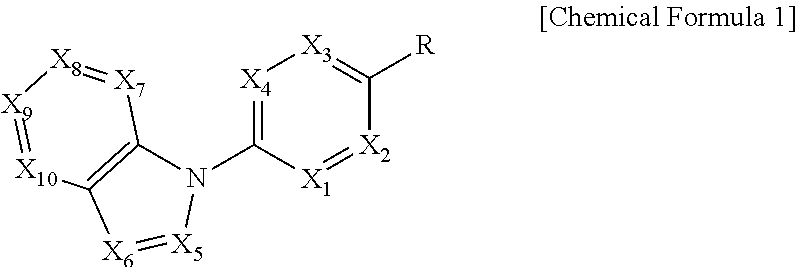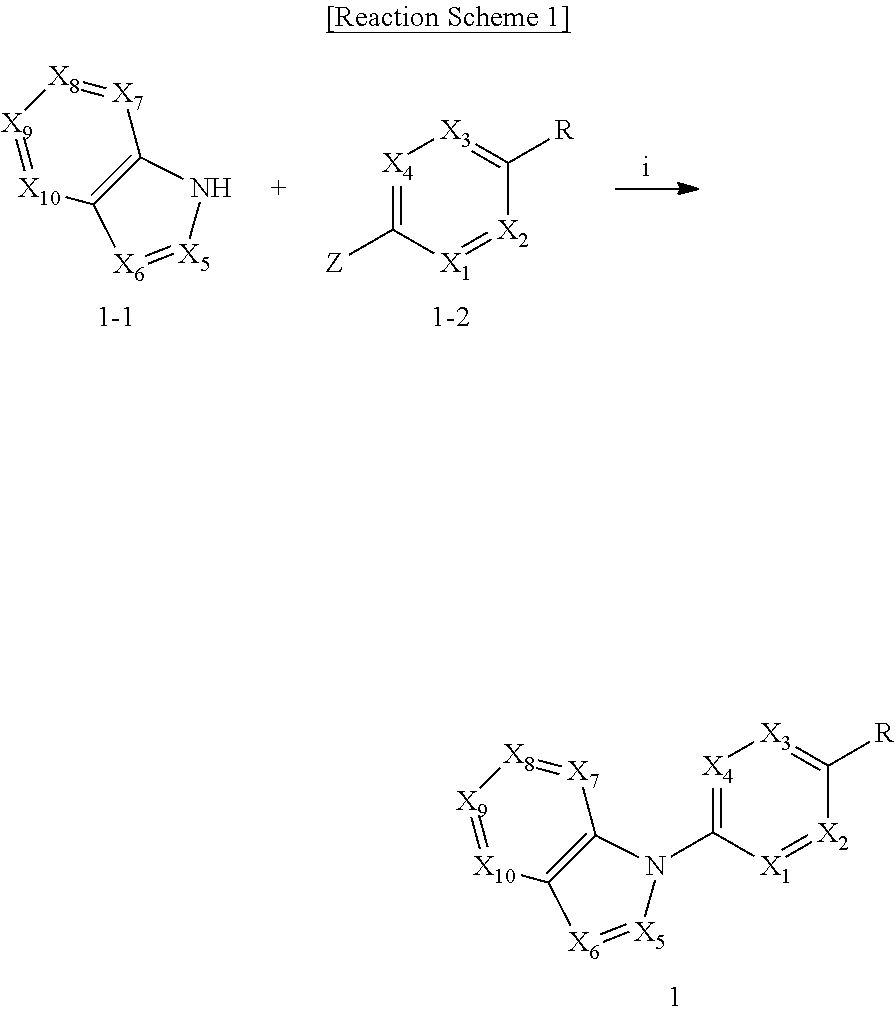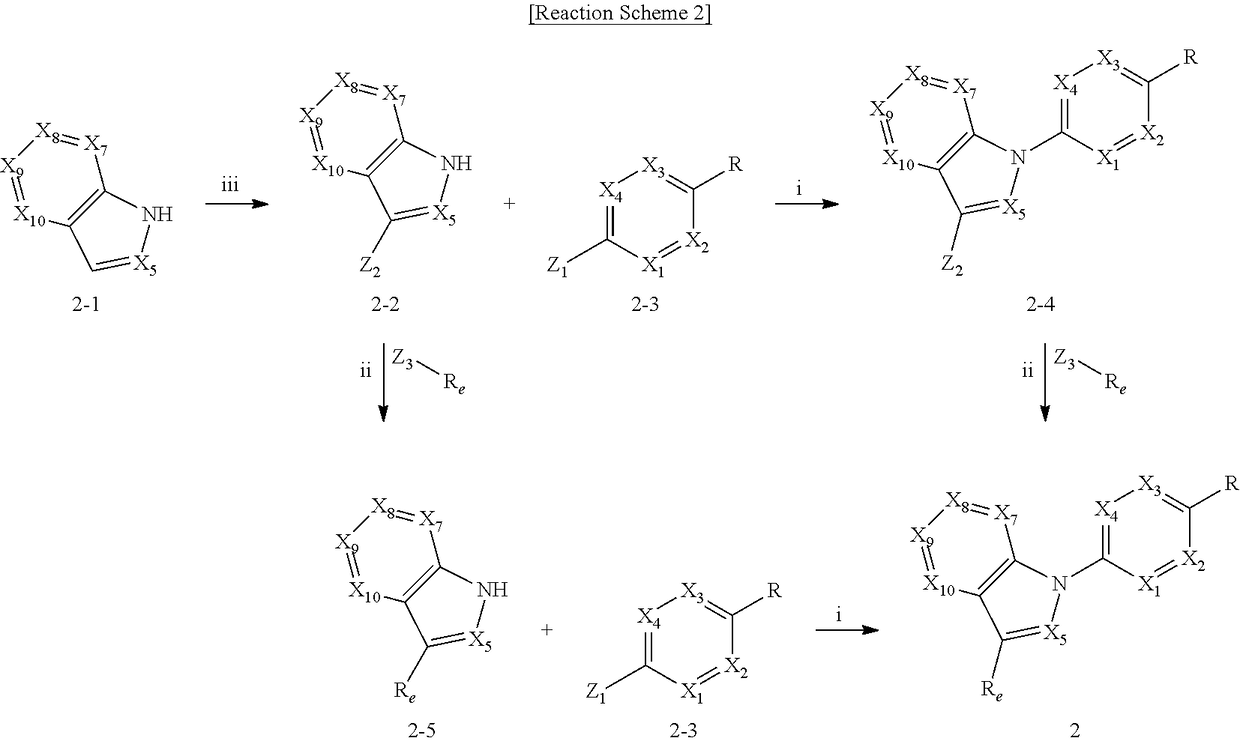Sodium channel blockers
- Summary
- Abstract
- Description
- Claims
- Application Information
AI Technical Summary
Benefits of technology
Problems solved by technology
Method used
Image
Examples
example 1
) Preparation of (5-chloro-4-(5-chloro-3-methyl-1H-indazol-1-yl)-2-fluoro-N-(methylsulfonyl)benzamide
[0426]
[0427]0.2 g (1.2 mmol) of 5-chloro-3-methyl-1H-indazole was dissolved in 10 mL of anhydrous N,N-dimethylformamide to which 0.78 g (2.4 mmol) of cesium carbonate and 0.32 g (1.2 mmol) of 5-chloro-2,4-difluoro-N-(methylsulfonyl)benzamide were added. The reaction mixture was stirred at 150° C. for 1 hour, and the organic layer was separated, treated with magnesium sulfate, filtered and then concentrated under reduced pressure. The residue was separated by column chromatography to give 0.15 g (30% yield) of the title compound.
[0428]1H NMR (MeOD) δ: 7.84 (s, 1H), 7.82-7.81 (d, 1H), 7.45-7.43 (d, 2H), 7.30-7.28 (d, 1H), 3.30 (s, 3H), 2.60 (s, 3H)
example 6
) Preparation of 4-(3-acetamido-5-chloro-1H-indazol-1-yl)-5-chloro-2-fluoro-N-(methylsulfonyl)benzamide
[0429]
[0430]0.1 g (0.24 mmol) of 4-(3-amino-5-chloro-1H-indazol-1-yl)-5-chloro-2-fluoro-N-(methylsulfonyl)benzamide was dissolved in 5 mL of anhydrous tetrahydrofuran to which 0.018 g (0.24 mmol) of acetyl chloride was added. The reaction mixture was stirred at room temperature for 2 hours, and the organic layer was separated, treated with magnesium sulfate, filtered and then concentrated under reduced pressure. The residue was separated by column chromatography to give 0.033 g (30% yield) of the title compound.
[0431]1H NMR (MeOD) δ: 7.80-7.99 (d, 1H), 7.64-7.62 (d, 1H), 7.40-7.38 (d, 1H), 7.28-7.27 (d, 2H), 3.15 (s, 3H), 2.25 (s, 3H)
example 24
) Preparation of 5-chloro-4-(3-chloro-5-cyclopropyl-1H-indazol-1-yl)-2-fluoro-N-(methylsulfonyl)benzamide
[0432]
[0433]25 mL of tetrahydrofuran was added to 1.0 g (7.0 mmol) of zinc(II) chloride under nitrogen conditions to which 4.0 mL (7.0 mmol, 1.7 M tetrahydrofuran) of cyclopropyl magnesium bromide was added, followed by stirring at room temperature for 30 minutes. The reaction mixture was added to 0.4 g (1.72 mmol) of 5-bromo-3-chloro-1H-indazole under nitrogen conditions, and then reacted with microwave reactor at 100° C. for 10 minutes. The organic layer was separated and concentrated under reduced pressure. The residue was separated by column chromatography to give 0.24 g (80% yield) of 3-chloro-5-cyclopropyl-1H-indazole.
[0434]1H NMR (MeOD) δ: 7.36 (d, 1H), 7.29 (s, 1H), 7.18 (d, 1H), 2.00 (m, 1H), 0.95 (d, 2H), 0.68 (d, 2H)
[0435]0.10 g (18% yield) of the title compound was prepared in the same manner as described in Example 1, except that 3-chloro-5-cyclopropyl-1H-indazole wa...
PUM
 Login to View More
Login to View More Abstract
Description
Claims
Application Information
 Login to View More
Login to View More - R&D
- Intellectual Property
- Life Sciences
- Materials
- Tech Scout
- Unparalleled Data Quality
- Higher Quality Content
- 60% Fewer Hallucinations
Browse by: Latest US Patents, China's latest patents, Technical Efficacy Thesaurus, Application Domain, Technology Topic, Popular Technical Reports.
© 2025 PatSnap. All rights reserved.Legal|Privacy policy|Modern Slavery Act Transparency Statement|Sitemap|About US| Contact US: help@patsnap.com



